In this article, I’ll be reviewing the 10 best lenses for Fujifilm X-T30 mirrorless camera.
I will also provide an actionable Buyers Guide and a FAQ section to make your purchase well-informed and easier.
I’ll be looking into many different details and providing useful information on various compatible Zoom and Prime lenses so that you will know which is the best lens for your new Fujifilm X-T30 mirrorless camera.
Editors' Picks
Best Overall Prime Lens
Fujinon XF 16mm f/1.4 R WR
This wide-angle, “very fast”, weather-resistant prime lens has two aspherical elements and two extra-low dispersion elements, which are both going to team up well together to block out many different kinds of aberrations.
Rounded nine-blade diaphragm means it’s best for bokeh!
It`s a great landscape lens and fast enough as well for Astrophotography!
See the review section for in-depth tech details and pros & cons!
Best Overall Zoom Lens (My Favorite)
Fujinon XF 100-400mm f/4.5 – 5.6 R LM OIS WR
This super telephoto zoom lens is the Grand Daddy of them all boasting the longest focal length of them all.
This is the telephoto lens they had in mind when defining the word “telephoto”!
Pair that with the quick and near-silent Twin Linear AF motors and the five stop-effective optical image stabilization system as well as excellent weather resistance, and you have yourself the best lens for outdoor, sports and wildlife photography.
This lens has some of the most advanced features, so the price tag obviously needs to reflect that!
See the review section for in-depth tech details and pros & cons!
Best Budget Prime Lens
Fujinon XF 23mm f/2 R WR
This budget prime lens is designed to be a compact lens great for travel with much upside.
One drop in quality would be the aperture, measured at f/2.
See the review section for in-depth tech details and pros & cons!
Best Budget Zoom Lens
Fujinon XF 18-55mm f/2.8 – 4 R LM OIS
This budget zoom lens has a faster maximum aperture (f/2.8 – 4) than most of the zoom lenses.
It does basically good in all aspects, but it isn’t the best in any of them. It’s an affordable and satisfactory lens for daily use and travel.
See the review section for in-depth tech details and pros & cons!
Best Value Prime Lens
Fujinon XF 23mm f/2 R WR
It`s good for landscape photography, and definitely has an advantage with outdoor photography in that it`s weather resistant.
Its design is suitable for use in as low as 14 degrees Fahrenheit and protects from dust and moisture from getting in and ruining the lens.
See the review section for in-depth tech details and pros & cons!
Best Value Zoom Lens
Fujinon XF 18-135mm f/3.5 – 5.6 R LM OIS WR
Down to quite a wide angle and up to a decent telephoto, this zoom lens is a fantastic all-around one.
The aperture is not the best of the zoom lenses (ranging from f/3.5 – 5.6), though it is still quite good for its intended use.
No matter the weather, temperatures as cold as 14 degrees Fahrenheit, this lens can be your rainy-landscape option or perhaps your Arctic-Travel Buddy!
See the review section for in-depth tech details and pros & cons!
With so many stunning photographs we’ve seen in our lifetime, it’s become more and more apparent that capturing amazing photos can be achieved by almost anyone.
That is, as long as you know what you need.
The Fujifilm X-T30 is an incredible new mirrorless camera, capable of producing excellent photographs.
Also, it is one of the best mirrorless cameras for Vlogging.
The quality is amplified when choosing the correct lens to pair with it.
But how do you know which lens is right for you?
To choose the best lens for Fujifilm X-T30, you need to answer some questions about how you plan to use it ahead of time.
Do you have specific projects in mind?
Do you have a certain type of photography you will be dabbling in?
There’s a lot to think about for a decision such as this. But knowing answers to these, and other questions is very important.
Learning the advantages and disadvantages of each lens is helpful as well.
FujiFilm X-T30 Mirrorless Camera:
If you know about the Fujifilm X-T3, then you may already know a bit about the Fujifilm X-T30 or you might already own it.
The X-T30 is smaller and lighter than the X-T3 but still has many of the same great qualities.
Performance is near the same, while being more compact and less expensive, you can see why this is such a desirable camera for many.
Some great features include the touch screen’s ability to tilt, also it’s “Touch Focus Area Selection”, “Touch Function”, and “Touch Shot” meaning the touch screen itself can do so much of what you need and allow you the ability to work quicker and smarter.
4K video recording is available with this camera, and much more. See the recent article!
BTW, the new mirrorless Fujifilm X-T200 & Fujifilm X-T4 are also on the market. So, make sure to read our recent articles on their best compatible lenses!
Call For The Right Lens:
It’s easy to see the Fujifilm X-T30 is an amazing piece of technology.
So, shouldn’t you think long and hard about what lens or lenses you will equip it with?
What will you be using this camera for mostly?
Photographing live sports?
Outdoor?
Indoor?
Low-light?
What kind of budget do you have?
Are you more interested in a prime lens or a zoom lens?
Maybe multiple questions listed here apply to your situation.
Maybe you have different questions needing answers.
Maybe you are considering multiple lenses.
No matter the question, I’ll be helping you to answer them, so that you can wisely determine what’s the best lens for Fujifilm X-T30.
Let’s dive right in then…
Note:
Some Letters and Letter Combinations in the lens names have specific meaning, which are helpful to know before looking at the different lenses.
First off, there are two main classifications of lenses in the Fujifilm family:
XC – Compact, lighter, more portable, cheaper.
XF – More sturdy construction. Aiming for the most exceptional image quality and overall performance.
Additional Letter Combinations to know:
R – Denotes there is a manual aperture ring.
A – Denotes there is automatic aperture control in certain modes.
WR – Weather Resistant.
OIS – Optical Image Stabilization.
LM – Linear Motor.
BTW, chances are high if you also want to read our recent articles on the best lenses for:
and the new mirrorless Fujifilm X-T200 or Fujifilm X-T4 as well…
What are the Best Lenses for Fujifilm X-T30 in 2021?
Quick Answer:
Best Prime Lenses for Fujifilm X-T30
Best Zoom Lenses for Fujifilm X-T30
Comparison Table for the Best Prime Lenses for Fujifilm X-T30
| Camera Lens | On Amazon | Aspherical Elements | Extra-Low Dispersion Elements | Coating / Weather Resistance | Diaphragm |
|---|---|---|---|---|---|
| Fujinon XF 14mm f/2.8 R |
 |
2 | 3 | Super EBC Coating / No | Rounded seven-blade |
| Fujinon XF 16mm f/1.4 R WR |
 |
2 | 2 | HT-EBC and Nano-GI Coating / Yes | Rounded nine-blade |
| Fujinon XF 23mm f/1.4 R |
 |
1 | 0 | Super EBC Coating / No | Rounded seven-blade |
| Fujinon XF 23mm f/2 R WR |
 |
2 | 0 | Super EBC Coating / Yes | Rounded nine-blade |
| Fujinon XF 56mm f/1.2 R |
 |
1 double-sided | 2 | Super EBC Coating / No | Rounded seven-blade |
Comparison Table for the Best Zoom Lenses for Fujifilm X-T30
| Camera Lens | On Amazon | Aspherical Elements | Extra-Low Dispersion Elements | Coating / Weather Resistance | Diaphragm |
|---|---|---|---|---|---|
| Fujinon XF 18-55mm f/2.8 - 4 R LM OIS |
 |
3 | 1 | Super EBC Coating / No | Rounded seven-blade |
| Fujinon XF 50-140mm f/2.8 R LM OIS WR |
 |
0 | 5 and one Super ED Element | HT-EBC and Nano-GI Coating / Yes | Rounded seven-blade |
| Fujinon XF 10-24mm f/4 R OIS |
 |
4 | 3 | Super EBC Coating / No | Rounded seven-blade |
| Fujinon XF 18-135mm f/3.5 - 5.6 R LM OIS WR |
 |
4 | 2 | HT-EBC Coating / Yes | Rounded seven-blade |
| Fujinon XF 100-400mm f/4.5 - 5.6 R LM OIS WR |
 |
0 | 5 and one Super ED Element | HT-EBC Coating / Yes | Rounded nine-blade |
Best Prime Lenses for Fujifilm X-T30 in 2021
1. Fujinon XF 14mm f/2.8 R
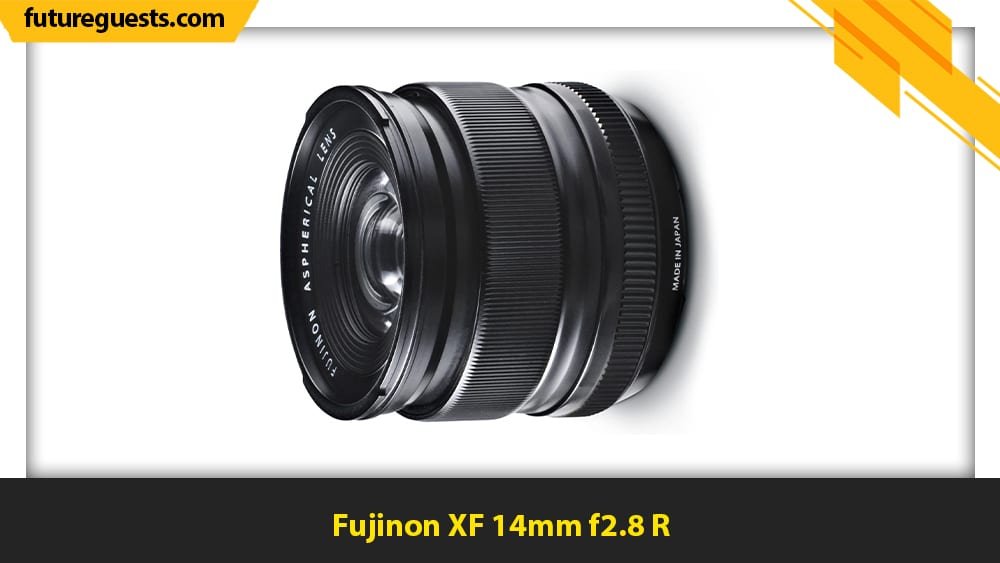
For beginners, the Fujinon XF 14mm f/2.8 R has a 14mm focal length (21mm equivalent focal length), which is the lowest of the prime lenses being reviewed.
That means you can get the widest angle when shooting with this prime lens.
The aperture is measured at f/2.8, so this isn’t the fastest prime lens allowing the most light in, but it’s still good.
This lens is considered fast enough for landscapes and architecture photography.
The lens has two aspherical elements and three extra-low dispersion elements.
Of the prime lenses being reviewed, it has the most extra-low dispersion elements and appears to the best at reducing color fringing and chromatic aberrations.
It has the Super EBC Coating on individual elements to reduce ghosting and lens flare.
Additionally, the lens has a rounded seven-blade diaphragm, good to know for you bokeh-lovers out there.
Pros
- Wide-angle (widest of the primes)
- Decent number of elements to block out aberrations
- Cost is decent for the quality
Cons
- Aperture is only Okay
- Super EBC Coating not the best possible
- Produces good bokeh, but not the best
Expert Opinion:
2. Fujinon XF 16mm f/1.4 R WR

Compared to the last lens, this one has a 16mm focal length (24mm focal length equivalent), so it doesn’t give you quite as wide an angle, but still very wide.
The aperture on this lens is much better than the last, at a very fast f/1.4.
Another great landscape lens and additionally is fast enough for Astrophotography!
This lens has two aspherical elements and two extra-low dispersion elements which are both going to team up well together to block out many different kinds of aberrations.
To reduce lens flare and ghosting, this lens has gone the route of incorporating HT-EBC being applied to the entire surface and also, Nano GI applied to some lens elements.
And this lens touts a rounded nine-blade diaphragm for the bokeh lover in you.
The weather-resistant scheme on this lens has nine different seals in eight locations.
Fujifilm’s weather-resistant design is amazing at blocking out dust and moisture, and is suitable in harsh conditions, including temperatures as low as 14 degrees Fahrenheit.
A fast aperture and excellent weather-resistance…
don’t worry if skies are not clear; you can take this lens to the ballgame.
Or for any outdoor activities, this lens is indeed a great companion for your Fujifilm X-T30.
Pros
- Also, a wide-angle (second best of the prime lenses)
- Great weather-resistant material and HT-EBC along with Nano GI Coating
- Fast aperture
- Rounded nine-blade diaphragm means it’s best for bokeh
Cons
- Not quite as many elements as the 14mm above
- More expensive
Expert Opinion:
3. Fujinon XF 23mm f/1.4 R
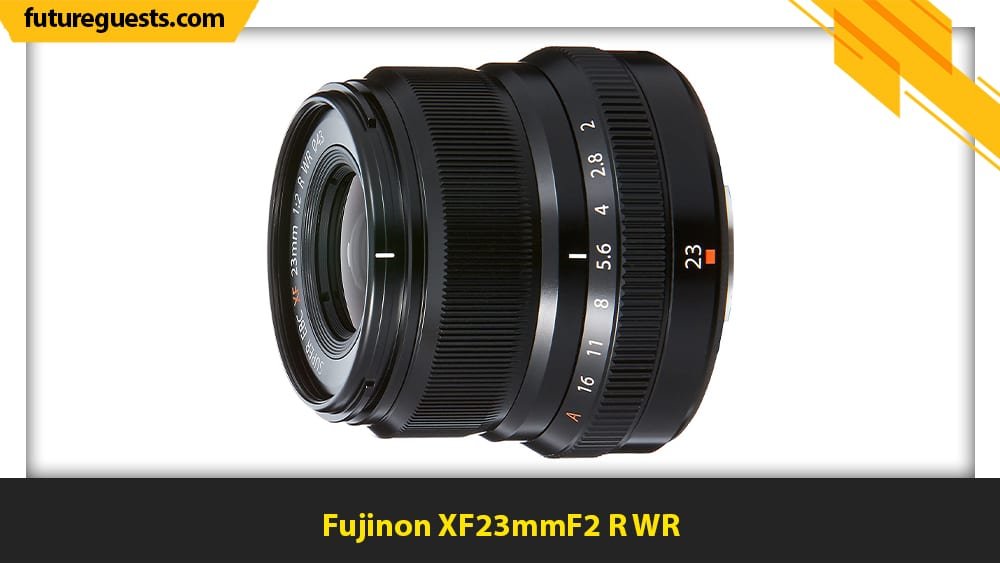
Now, we’ve moved up to a 23mm focal length range (35mm focal length equivalent), so less of a wide-angle for this lens.
Keeping with the same fast aperture of f/1.4, this is another lens great for landscape, maybe better for some slightly more close-up photography, such as street, city, wedding photography and great for low-light conditions.
This lens has just one aspherical element, so it can block out spherical aberrations and distortion, but is not known to be the lens best for that.
It has Super EBC Coating for reduction of lens flare and ghosting.
And, like the 14mm lens, it has a rounded seven-blade diaphragm, which is big for the bokeh.
Pros
- Fast aperture
- Decent price
- Angle is still fairly wide
Cons
- Limited number of elements
- Only has Super EBC Coating
- Produces good bokeh, but not the best
Expert Opinion:
4. Fujinon XF 23mm f/2 R WR
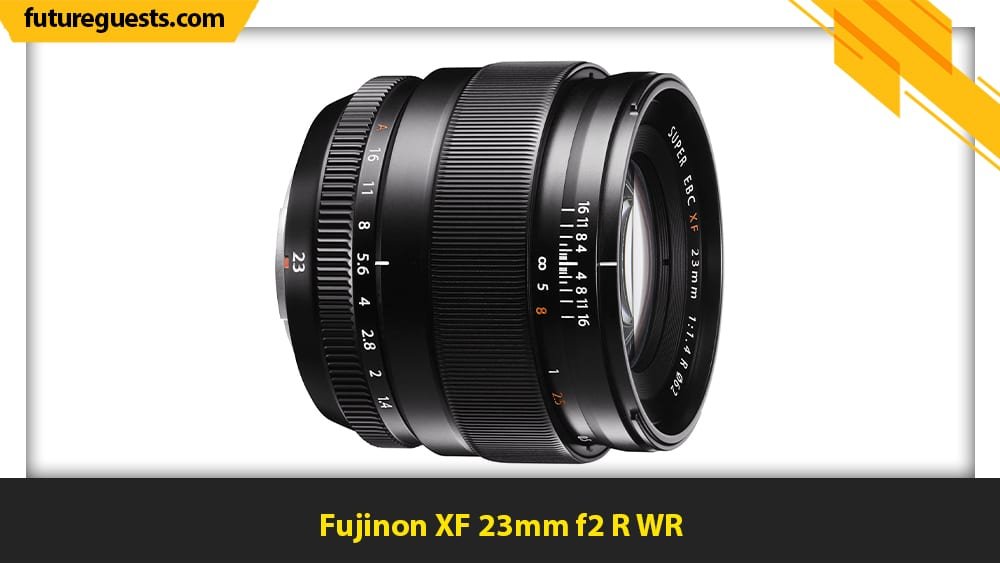
Right off the bat, you likely notice that the XF 23mm f/2 R WR has the same focal length range as the last one; that being 23mm (35mm focal length equivalent).
Similarly, it has also a Super EBC Coating.
A few big differences here though.
One drop in quality would be the aperture, measured at f/2.
Still good for landscapes, and definitely has an advantage with outdoor photography in that it is weather-resistant.
The design is suitable for use in as low as 14 degrees Fahrenheit and protects from dust and moisture from getting in and ruining the lens.
This lens does have two aspherical elements.
Additionally, it has a rounded nine-blade diaphragm.
So, it is better in reducing distortion and spherical aberrations and produces greater bokeh effect than the other 23mm option.
This lens is designed to be a compact lens great for travel with much upside.
With little downside to this lens, the price tag that comes along with it makes it appear to almost be a steal!
Pros
- Weather-resistant
- Best for bokeh of the prime lenses with a rounded nine-blade diaphragm
- Very inexpensive
Cons
- Better than other 23mm in terms of elements but still lacks compared to others in blocking out aberrations
- Aperture is not so fast
- Only has Super EBC Coating
Expert Opinion:
5. Fujinon XF 56mm f/1.2 R
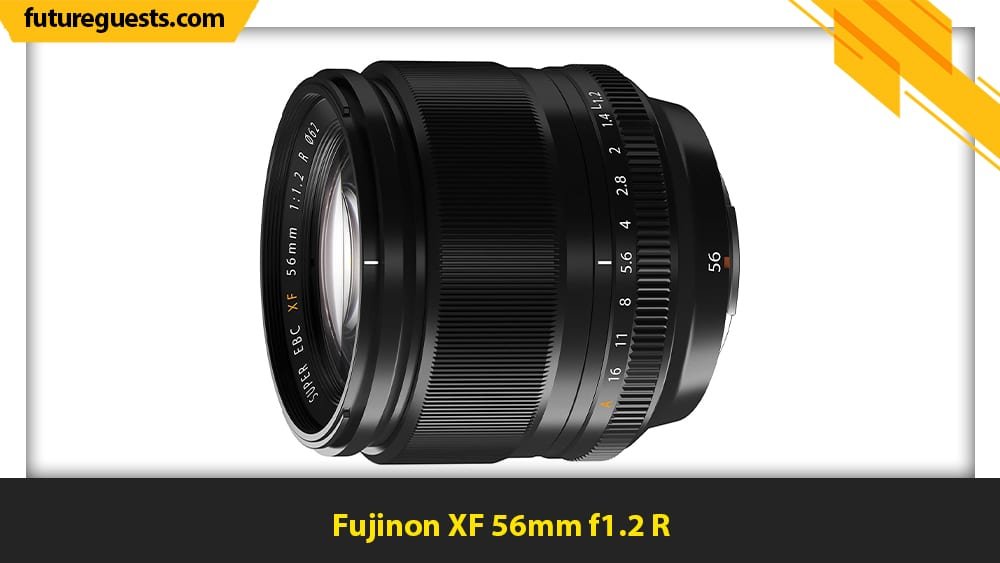
This 56mm focal length (85mm equivalent) is right on that border of almost being considered a telephoto lens.
The Fujinon XF 56mm f/1.2 R would fare better with tighter shots and high-quality portraits.
The aperture on this lens is f/1.2, which is incredibly fast.
This would be an ideal lens for indoor sports or any low-light condition as this is the fastest lens we have looked at among the prime lenses.
A rounded seven-blade diaphragm falls right into the middle of the pack with most of these lenses for decent bokeh.
This lens has two extra-low dispersion elements and also one double-sided aspherical element.
These will help you to limit many types of aberrations in order to produce the highest quality images with great sharpness and color.
As is quite common, a Super EBC Coating has been applied to individual elements on this lens.
Say bye-bye to ghosting and lens flare.
This prime lens is a prime choice as you can see, exceling in many areas.
Pros
- Fastest aperture of all the prime lenses reviewed
- Decent number of elements to block out aberrations
- Highest quality in most respects
Cons
- Least wide angle of all the lenses, closer to telephoto
- Only has Super EBC Coating
- More expensive
Expert Opinion:
Best Zoom Lenses for Fujifilm X-T30 in 2021
6. Fujinon XF 18-55mm f/2.8 - 4 R LM OIS
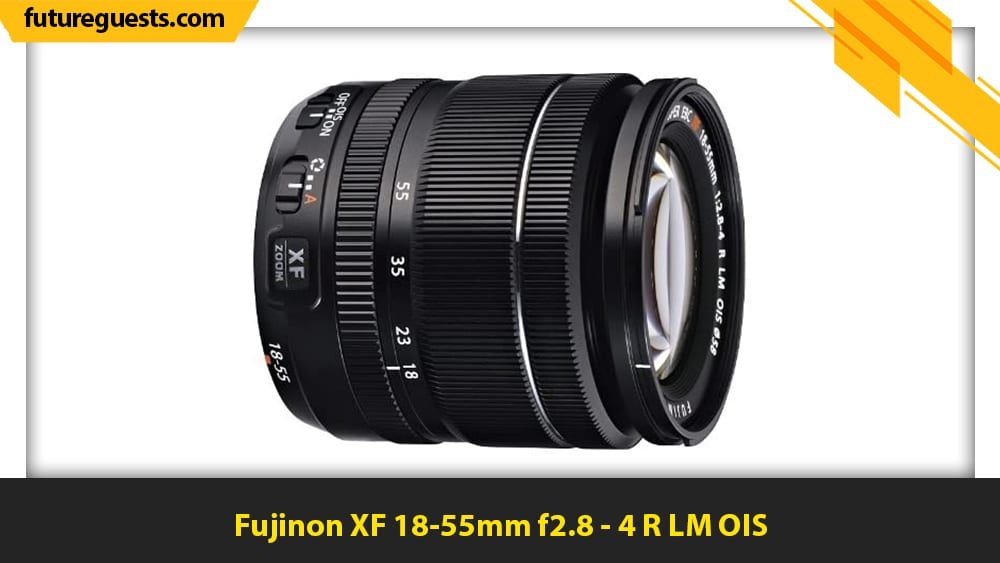
This zoom lens has an 18-55mm focal length (27-84mm focal length equivalent).
Of the zoom lenses being reviewed here, this one lands pretty much right in the middle in terms of range.
The aperture measures at f/2.8 – 4, which is a decent range for a zoom lens.
Faster maximum aperture than most of the zoom lenses here.
This lens has one extra-low dispersion element to curtail color fringing and chromatic aberration, but does so to the least extent of all these zoom lenses.
It also has three aspherical elements, in order to reduce distortion and spherical aberrations, and lands just about in the middle of the pack in terms of its ability to do so.
It has the common Super EBC Coating to lessen ghosting and lens flare.
Also, it possesses an Optical Image Stabilization paired with an enhanced gyro sensor to reduce camera shake and a Linear Motor for autofocusing.
These qualities are quite commonplace for the Fujifilm zoom lenses.
Additionally, it has a rounded seven blade diaphragm affording the ability for shallow depth of field techniques and creating great bokeh.
All the zoom lenses reviewed here have at least a rounded seven blade diaphragm, so this is fairly common.
Noticing a trend?
This lens does basically good in all aspects, but it isn’t the best in any of them.
It’s an affordable and satisfactory lens for daily use and travel.
Pros
- Decent number of spherical elements to prevent spherical aberrations
- Affordable zoom lens that’s decent in all aspects
- Good lens for daily use and travel
Cons
- Only one extra-low dispersion element to limit chromatic aberrations
- This zoom lens is not the best in any one particular area
- Only has Super EBC Coating
Expert Opinion:
7. Fujinon XF 50-140mm f/2.8 R LM OIS WR
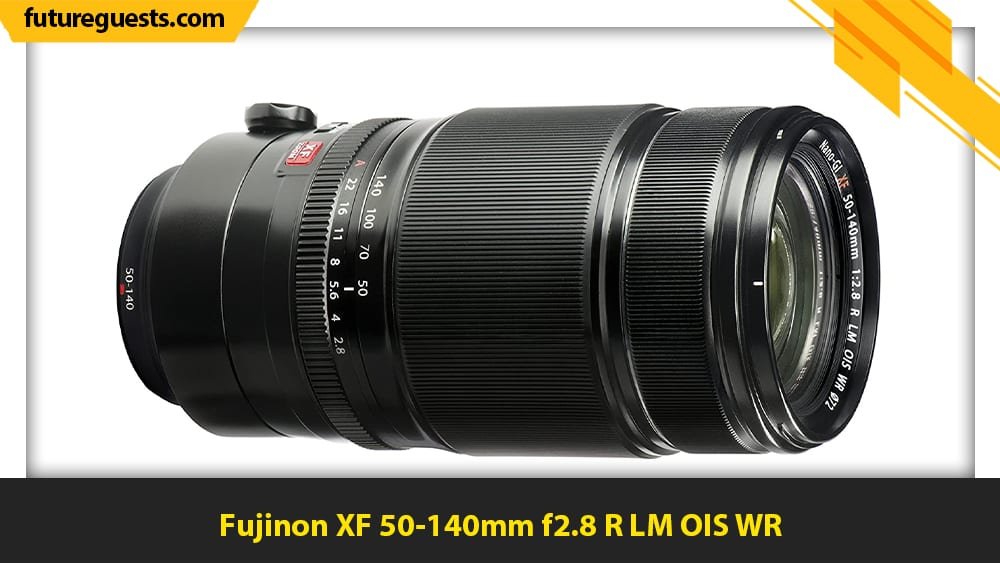
With Fujinon XF 50-140mm f/2.8 R LM OIS WR, we have a 50-140mm focal length (76-213mm focal length equivalent) for some great range on this telephoto lens.
A consistent f/2.8 aperture means consistent light throughout the zoom range.
It has also the fastest aperture among all these zoom lenses.
The optical image stabilization system and Triple Linear Motor AF system offers exquisite focusing performance.
There are five extra-low dispersion elements and one Super ED element.
Along with the Fujinon XF 100-400mm f/4.5 – 5.6 R LM OIS WR (covered later on), that’s the best zoom lens at eliminating color fringing and chromatic aberrations.
This powerhouse lens has HT-EBC Coating along with a Nano-GI Coating and thus provides excellent protection against ghosting and lens flare.
And feel free to take it outside!
The Weather-Resistant design showcases 20 distinct weather seals.
That makes it useable in temperatures as low as 14 degrees Fahrenheit, protects against dust, moisture, bad weather… just about anything Mother Nature can throw at you.
And don’t forget the rounded seven-blade diaphragm.
Use this lens for artistic bokeh, low-light situations, sports, outdoor activities, you name it.
Pros
- Fastest aperture of all the zoom lenses and is consistent throughout zoom
- Weather-resistant and has HT-EBC and Nano-GI Coating to protect from lens flare and ghosting
- Five extra-low dispersion elements and one Super ED element to stop chromatic aberrations
- Triple Linear Motor AF system offers exquisite focusing performance
Cons
- More expensive
- Good for bokeh, but not the best
- Decent zoom range, but not the best of the zoom lenses
Expert Opinion:
8. Fujinon XF 10-24mm f/4 R OIS

The focal length range of 10-24mm (15-36mm equivalent focal length) gives you the option of the lowest focal length at 10.
That’s the widest angle you will get from all these lenses and you are still afforded some flexibility.
The ultimate lens for landscape!
The aperture of Fujinon XF 10-24mm f/4 R OIS is a consistent f/4.
That’s not bad, right about in the middle of this particular pack of zoom lenses.
It has the very common Super EBC Coating applied to individual elements to limit some ghosting and lens flare.
With its three extra-low dispersion elements and four aspherical elements, this particular zoom lens finds itself on the higher end in terms of blocking out all types of aberrations.
A rounded seven-blade diaphragm, like many others, let you capture some great bokeh, if that’s what you’re looking for.
This zoom lens does have an Optical Image Stabilization system; however, it has a Stepping Motor, which seems to be a better fit if your purposes are video-driven.
Pros
- Has the widest angle available of all the zoom lenses
- Three extra-low dispersion elements and four aspherical elements. Great at preventing aberrations
- Decent price for some great qualities
Cons
- Zoom range is by far the lowest of all the zoom lenses
- Only has Super EBC Coating
- Has a Stepping Motor as opposed to a Linear Motor
Expert Opinion:
9. Fujinon XF 18-135mm f/3.5 - 5.6 R LM OIS WR
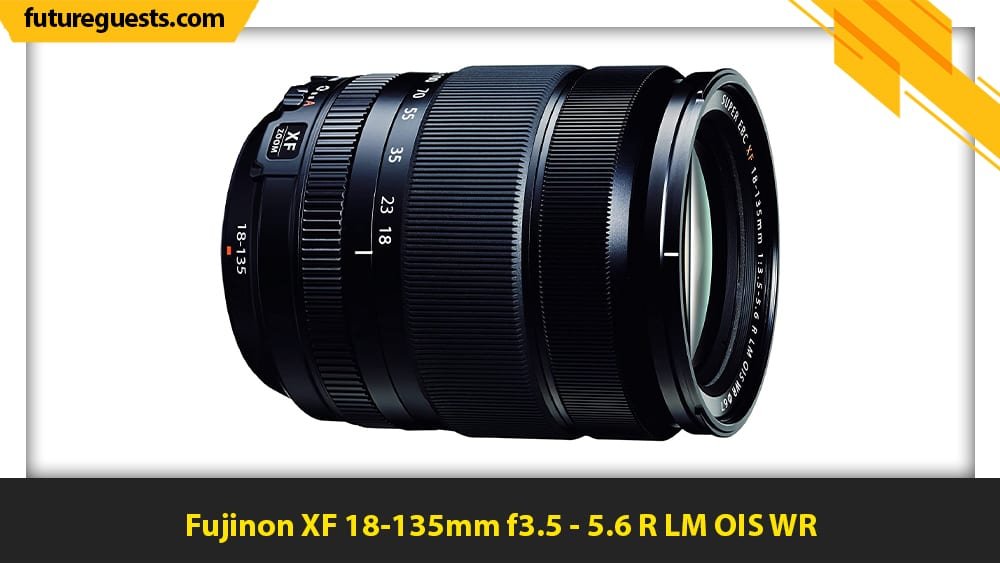
The Fujinon XF 18-135mm f/3.5 – 5.6 R LM OIS WR zoom lens has a focal length range of 18-135mm (27-206mm equivalent), so you have quite a large range to work with.
Down to quite a wide angle and up to a decent telephoto, this is a fantastic all-around lens.
The aperture is not the best of the zoom lenses, ranging from f/3.5 – 5.6, but it is still quite good for its intended use.
20 distinct weather seals can be found on this weather-resistant lens, so feel free to take it out into the elements.
No matter the weather, temperatures as cold as 14 degrees Fahrenheit, this lens can be your rainy-landscape option or perhaps your Arctic-Travel Buddy.
It can block out some color fringing and chromatic aberrations with its two extra-low dispersion elements.
And forget about distortion and spherical aberrations, having the four aspherical elements is one of the best aspherical element situations you can find in these zoom lenses.
It has the top of the line HT-EBC coating applied to entire surface of each element in order to stop lens flare and ghosting in its tracks.
To prevent shakiness this lens has a quite capable Optical Image Stabilization system with an enhanced gyro sensor and a Linear Motor for quiet and accurate autofocus.
Yep, you guessed it. This lens also has rounded seven-blade diaphragm.
Bokeh, anyone?
Pros
- Great zoom range while still affording wide-angle
- Great number of elements for blocking out all types of aberrations
- Great weather-resistance along with HT-EBC Coating
- Quite inexpensive for all of the great qualities
Cons
- Aperture range is on the low-end
- Linear Motor is good, but not the best
- Produces decent bokeh, but not the best
Expert Opinion:
10. Fujinon XF 100-400mm f/4.5 - 5.6 R LM OIS WR

This lens is the Grand Daddy of them all with a focal length of 100-400mm (152-609mm equivalent focal length) boasting the longest focal length of them all.
This is the telephoto lens they had in mind when they defined the word telephoto.
Pair that with the quick and near-silent Twin Linear AF motors and the five stop-effective optical image stabilization system (which minimizes camera shake), and you have yourself the best lens for wildlife photography.
Is it okay to take it outside to photograph said wildlife?
Of course!
The lens body has 13 distinct weather seals in 12 locations along with some smart fluorine coating on the front element.
Dust, moisture, inclement weather, cold temperatures down to 14 degrees Fahrenheit, you know the drill.
This lens is prepared for it all.
Trying to keep the perfect zoom for a fascinating subject far away?
This lens has a zoom-lock switch to thwart that ever-annoying and unwanted zoom creep from occurring.
It also helps to maintain your same zoom position while you’re shooting.
This lens has the fantastic HT-EBC Coating to combat lens flare and ghosting so you will have no worries in that department.
One setback you can tell right off the bat, is the aperture of f/4.5 – 5.6, which is not the best, but the lens has to make a sacrifice somewhere.
But you’re also working with five extra-low dispersion elements and one Super ED element.
Color fringing and chromatic aberrations don’t stand a chance then.
And look what we have here!
A rounded nine-blade diaphragm! Here’s the lens that will let you bokeh with the best of them.
This lens has some of the most advanced features, so the price tag needs to reflect that.
Pros
- Best zoom range of all the zoom lenses, plus it has zoom-lock switch to prevent zoom-creep
- Weather-resistant along with the HT-EBC Coating
- Twin Linear AF motors; one of the best available
- A rounded nine-blade diaphragm for the best bokeh of all the zoom lenses
Cons
- Lowest aperture of all the zoom lenses
- Most expensive lens reviewed
Expert Opinion:
Best Lenses for Fujifilm X-T30 (2021) — Buyers Guide
Now that I have covered multiple prime lenses and multiple zoom lenses, it’s time to think about what you want SPECIFICALLY and pinpoint the best lens for Fujifilm X-T30.
What are the questions you need to have answered in order to make your most informed decision?
A big question would likely be involving COST!
Is the cost of no concern?
Some concern?
Is it a large factor in your decision-making process?
What are your intended uses?
Do you have particular hobbies your lens will be accompanying you during?
Are you likely going to be enduring a fair amount of changing weather in your endeavors?
Do you want to showcase your artistic side?
Is this going to be for kids’ soccer and baseball games?
You know the questions you have.
Maybe you’re still pondering more possible questions to ask.
I’ll give you a list of some frequently asked questions (FAQ) and corresponding answers and maybe that will also help you find the best lenses for Fujifilm X-T30.
What is the most budget friendly lens for Fujifilm X-T30?
If it’s a prime lens you want cheap, go with the Fujinon XF 23mm f/2 R WR which is just about $500.
Looking for the cheapest zoom lens?
You’d want the Fujinon XF 18-55mm f/2.8 – 4 R LM OIS priced at about $700.
If I don’t care about cost, what are the absolute best lenses for Fujifilm X-T30?
For zoom lenses, I say this is a bit of a toss-up.
My choice would be the Fujinon XF 100-400mm f/4.5 – 5.6 R LM OIS WR.
It’s weather-resistant; it has the best zoom, best for producing pleasing bokeh.
It has the incredible HT-EBC Coating, Twin Linear Motor, and the 5 extra-low dispersion and 1 Super ED elements hamper plenty of aberrations.
However, I could also see a case being made for the Fujinon XF 50-140mm f/2.8 R LM OIS WR as this is also weather-resistant, with more weather-resistant seals, superior HT-EBC and Nano-GI coating, Triple Linear Motor, the fastest aperture, and also has the 5 extra-low dispersion and 1 Super ED elements to hamper plenty of aberrations.
If you’re choosing between those two, it may come down to this simple question for you.
Which is more important?
Faster aperture or better zoom capability?
For prime lenses, it’s another toss-up.
I give the edge to the Fujinon XF 16mm f/1.4 R WR.
It has a fast aperture; it’s weather-resistant and has plenty elements to stop aberrations.
It has HT-EBC and Nano-GI coating, and has a nice wide angle.
But what I would call a close second… is the Fujinon XF 56mm f/1.2 R.
Not weather-resistant and only has Super EBC Coating, but it also has plenty elements to stop aberrations, has a nice near-telephoto lens, and possesses a faster aperture.
So, you may want to ask yourself two questions here.
Do you prefer the wide angle or not?
And would you prefer weather-resistant, or a faster aperture?
What are the best lenses for Fujifilm X-T30 if I want some "bang for my buck"?
Yes, to get the most for your dollar is important.
You don’t want to sacrifice too much money, but you don’t want to sacrifice too much quality.
For prime lenses I would say the Fujinon XF 23mm f/2 R WR.
I was honestly surprised how cheap this one is.
You’ll notice, of the five prime lenses reviewed, four of them are between $899.00 and $999.00.
This one, however, is only about $500.
You would think for being half the price, it would be half the quality.
You do sacrifice some things, but this one is actually weather-resistant.
It doesn’t have as fast an aperture as the other 23mm option, but it has more elements to protect from aberrations, and it has a rounded nine-blade diaphragm as opposed to just a rounded seven-blade diaphragm.
For zoom lenses, I would go with the Fujinon XF 18-135mm f/3.5 – 5.6 R LM OIS WR, the second cheapest one on the list.
It’s weather-resistant, and it’s far cheaper than the other two weather-resistant lenses on the list.
Priced at about $900, this lens has plenty of different elements in order to limit a variety of aberrations.
Additionally, it has the top of the line HT-EBC Coating, Linear Motor, Optical Image Stabilization system, just about everything you need.
What are the best lenses for Fujifilm X-T30 in terms of producing shots with great bokeh?
For prime lenses, you would want to go with rounded nine-blade diaphragm Fujinon XF 23mm f/2 R WR.
For zoom lenses, another rounded nine-blade diaphragm lens, the Fujinon XF 100-400mm f/4.5 – 5.6 R LM OIS WR would be your choice.
What are the best lenses for the Fujifilm X-T30 if I want fast apertures?
If a fast prime lens is what you’re looking for, look no further than the Fujinon XF 56mm f/1.2 R.
Want the fastest zoom lens?
Then, you want to choose the Fujinon XF 50-140mm f/2.8 R LM OIS WR.
What are the best lenses for Fujifilm X-T30 if I want to shoot wide angles/landscapes?
The widest angle you can get for the prime lenses would be the Fujinon XF 14mm f/2.8 R.
The widest angle you can get for a zoom lens is the Fujinon XF 10-24mm f/4 R OIS, and you’re still afforded some flexibility with the zoom.
What are the best lenses for Fujifilm X-T30 if I want them to be weather-resistant?
For prime lenses, the Fujinon XF 16mm f/1.4 R WR is your best weather-resistant option.
Great quality, fast aperture, ’all the fixins’.
For zoom lenses, I have to go with the Grand Daddy of them all… the Fujinon XF 100-400mm f/4.5 – 5.6 R LM OIS WR.
What are the best lenses for Fujifilm X-T30 if I want to use them for shooting outdoor sports/activities?
For prime lenses, I will first ask you a question.
Your outdoor sports/activities you’ll be shooting… might they be accompanied by some bad weather or precipitation?
If so, choose the weather-resistant Fujinon XF 16mm f/1.4 R WR.
Is it all clear skies and sunny days?
Then, go for faster aperture with the Fujinon XF 56mm f/1.2 R.
How about zoom lenses?
Time for me to ask you more questions again.
Is this say, your kid’s soccer/baseball/football game?
Some situation where the action is near enough?
Choose the Fujinon XF 50-140mm f/2.8 R LM OIS WR for fast aperture and still very good zoom capability.
Is this perhaps, a college or professional sporting event?
Some situation where your motto will be, the more zoom the better?
Then, choose the Fujinon XF 100-400mm f/4.5 – 5.6 R LM OIS WR.
You sacrifice aperture for better zoom.
Either zoom lens you choose, you won’t have to worry what the weather man says. They’re both weather-resistant.
Best Lenses for Fujifilm X-T30 (2021) — Conclusions
So many choices for lenses out there, it could make your head spin.
Now, in order to capture a good head spin, I’d probably want a fast aperture, right?
But in all seriousness, there’s tons of options.
Knowing your intended use beforehand will narrow down your decisions.
As will knowing your budget.
Soon enough, you’re comparing just a handful of these lenses.
Let me give you my breakdown of what I found to be the best lenses for Fujifilm X-T30 in several scenarios.
- If you want the absolute best lens for Fujifilm X-T30, choose the Fujinon XF 100-400mm f/4.5 – 5.6 R LM OIS WR as a zoom lens or choose the Fujinon XF 16mm f/1.4 R WR as a prime lens.
- If you’re a relatively new photographer still getting the hang of things, I’d say choose the prime lens Fujinon XF 23mm f/2 R WR.
If you don’t think having a zoom lens would add too much to your plate, maybe give the Fujinon XF 18-55mm f/2.8 – 4 R LM OIS a try.
- If you’re on a budget and just want a lens that is solid, choose the prime lens Fujinon XF 23mm f/2 R WR.
- If you’re on a budget but desire a zoom lens, then choose the Fujifilm XF 18-55mm f/2.8 – 4 R LM OIS.
- If landscaping is your game and aperture is most important, choose the Fujinon XF 14mm f/2.8 R.
- If landscaping is your game and you are less concerned with aperture and more concerned with a little zoom flexibility, then go with the Fujinon XF 10-24mm f/4 R OIS.
- Might be out in the rain trying to get some shots of wildlife from a far?
Try out the Fujinon XF 100-400mm f/4.5 – 5.6 R LM OIS WR.
- Might be out in the rain trying to get some shots of your child scoring a touchdown?
Try the Fujinon XF 50-140mm f/2.8 R LM OIS WR.
- Or maybe you’re still semi-undecided. You kind of like the idea of landscapes, but maybe you occasionally see beautiful animals in your back yard. Maybe your kids may take up some sport soon. The weather isn’t always great where you live.
I say if you’re somewhat undecided or you’re looking to do a little of several things, try the Fujinon XF 18-135mm f/3.5 – 5.6 R LM OIS WR. It’s great all-around and it’s a great value.
Hopefully, we helped you find the right Fujifilm X-T30 lens!
Good luck!








